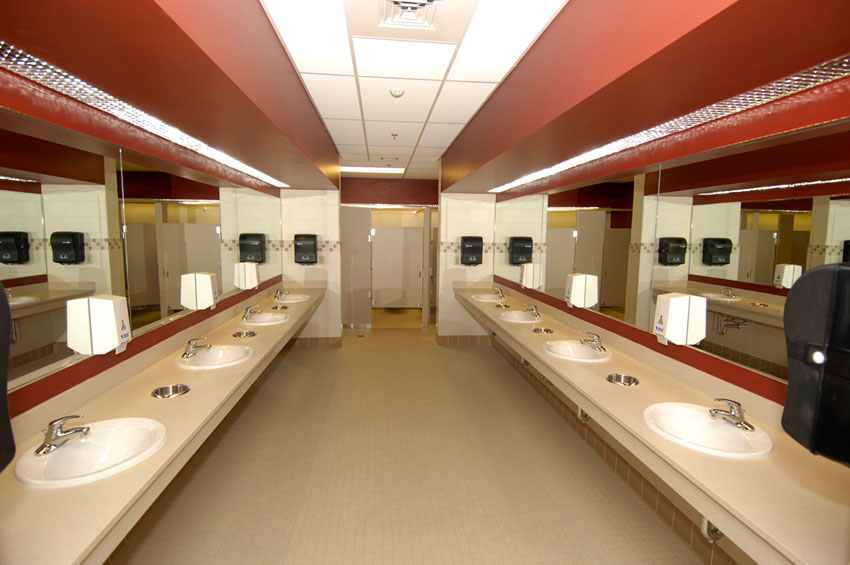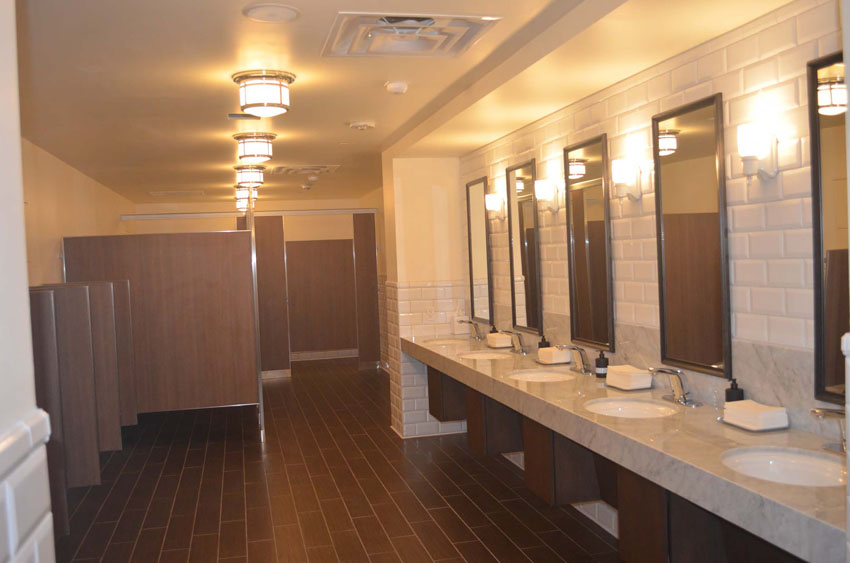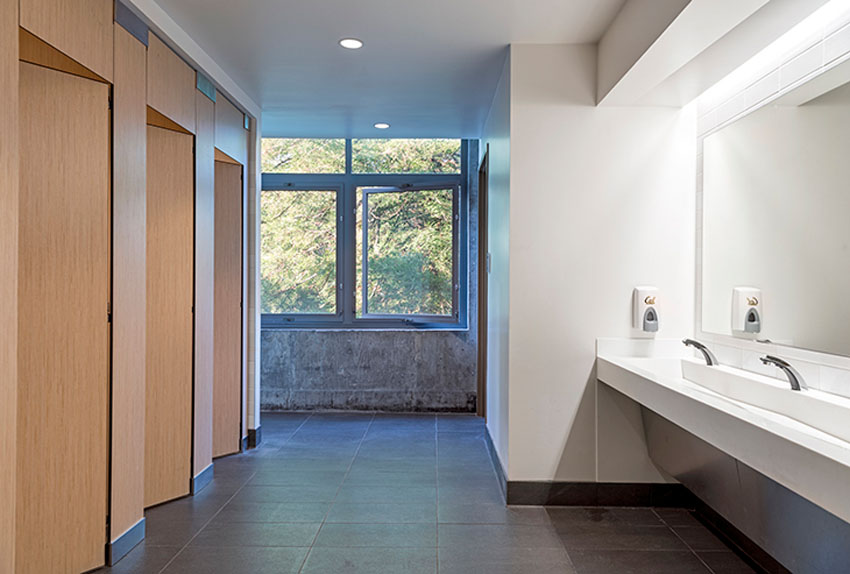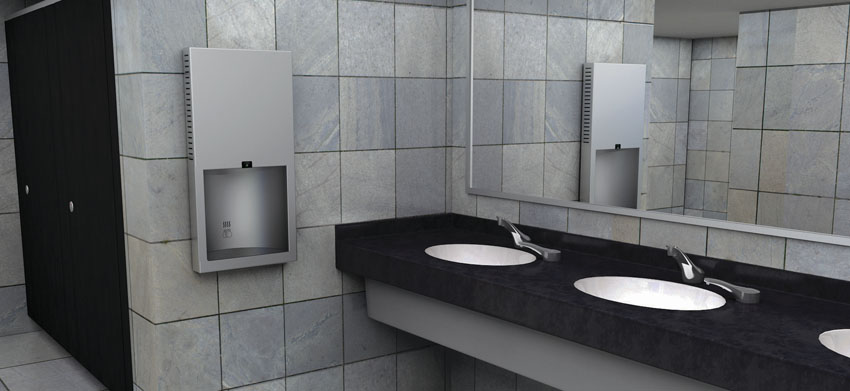Designing Restrooms for Sustainable Operation
Preserving Your Design Vision
As an architect, your value is intimately tied to the design recommendations that you provide.
By providing sustainable product specifications, you are providing good client service that benefits the facility. Although you may never actually see the restrooms you design after the initial installation, you and your firm will be evaluated on the design for years to come.
Therefore, by researching and specifying products that boast numerous benefits rather than just one or two, your design stands a better chance of withstanding challenges and value-engineering from the project’s various stakeholders.
By choosing products that are all at once aesthetically pleasing, sustainable, and easy to maintain, your original vision is more likely to endure rather than be disrupted by non-harmonizing products.
Case Studies
When restrooms utilize accessories that are not aesthetically integrated, industry professionals often refer to them as “Frankenrestrooms.” Often, these restrooms do not operate sustainably and create a fragmented, inefficient patron experience.

Photo courtesy the U.S. Airforce
Figure 2
Can you identify all of the design issues with the restroom pictured in Figure 2?
The soap dispensers are proprietary, wall-mounted units, and they do not harmonize with any other accessories. Since they are mounted on the mirror, they may cause excessive splashing on the counter, leading to increased maintenance and poor hygiene. The roll paper towel dispensers are large and bulky, and they do not harmonize with any other accessory. Finally, the manual faucets also may increase water use.

Photo courtesy of Bobrick Washroom Equipment, Inc.
Figure 3
Figure 3 shows a restroom in a high-end hotel lobby. Direct your attention to the counter, where you can see stacks of loose paper towels and a noncommercial soap dispenser. Both of these solutions are highly unsustainable.
In the photo, the soap dispenser is low capacity, which means the operator will have to refill it more often. The dispenser also does not match the overall aesthetic of the restroom.
Instead of a paper towel dispenser or hand dryer, loose stacks of paper towels are employed, which leads to waste. Patrons may grab a handful of towels, as opposed to an appropriate dispenser, which may limit dispensing lengths (in the case of roll towels) or ensure that only one towel is dispensed at a time (in the case of folded).
Finally, note that the lighting in this restroom is antiquated, utilizing incandescent light bulbs and no automatic sensors.

Photo: Jasper Sanidad Photography
Figure 4
Shown in Figure 4 is a gender-neutral restroom in a LEED-certified library at a major state university.
Notice the plastic, wall-mounted soap dispenser beside the counter. This compromises the overall design of the restroom, as the restroom features high-design products, such as privacy compartments and contemporary no-touch faucets.
At the Long Beach Convention and Entertainment Center in California, maintenance staff was having difficulty refilling the soap dispensers when soap ran out. This happened frequently due to busy trade shows and conferences. Since the system was a proprietary, cartridge-based system, it was necessary for maintenance personnel to crawl underneath the sinks to refill the cartridges.
Often, while they were replacing the cartridges, paneling under the sink would become dislodged and fall on workers.
In addition, due to the sheer number of dispensers and the size of the convention center, maintenance staff regularly would dispose of cartridges containing small amounts of soap to avoid making additional trips to and from the restrooms.
However, by switching to a manual bulk foam soap dispenser throughout the facility, they were able to replace their previous soap cartridges with jug foam soap. The dispenser’s top-fill design also significantly reduced the strain on their maintenance staff. Plus, the dispenser’s 34-ounce bottle capacity meant that maintenance staff returned for refills less often.
Ultimately, more than 300 units were installed throughout the entire convention center. After installing the dispensers, the convention center reported that it was spending 80 percent less on soap compared to the previous system.

Photo courtesy of Bobrick Washroom Equipment, Inc.
Figure 5
The illustration in Figure 5 depicts a highly sustainable, design-integrated restroom in a prestige facility. All accessories have clean forms and stainless-steel finishes that interact with the wall and floor patterns.
Note the function of each accessory as it relates to sustainable operation. The hand dryer not only eliminates the need to purchase or dispose of paper towel waste but also has a water-absorbing alcove that prevents water from splashing on the walls and floor. This reduces maintenance time for the facility operator, which equates to value and money for the owner.
The soap dispensers are top-fill bulk foam systems, which are easy to maintain, requiring no removal of ADA panels or bending under the counter to refill. Since they utilize bulk foam soap, they reduce water usage from hand washing and reduce plastic waste compared to cartridge-based systems. Since they are counter mounted, they minimize water splashing on the counter, which reduces maintenance. In addition, the soap dispensers are design integrated with the faucets to reinforce the harmonized aesthetic.
Since all of these products enable sustainable, cost-saving operation, the integrated aesthetic of the restroom is much more likely to withstand challenges to the specification and survive for years to come.









